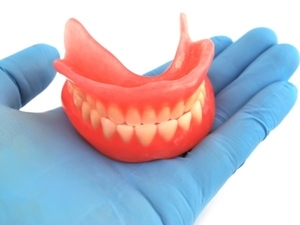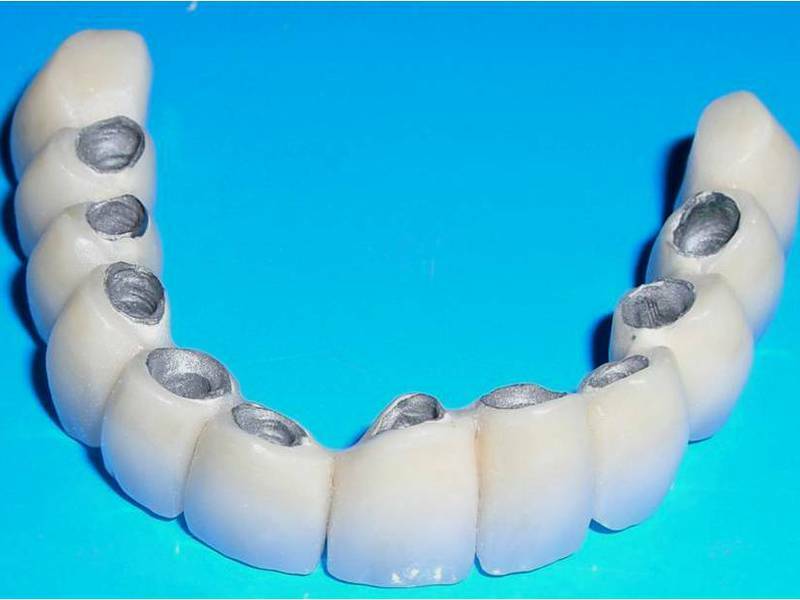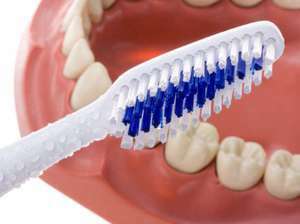Фиксни протеза нова генерација: мост изградња система
In modern clinics the technique of prosthetics has advanced far and has presented to the world various types of removable and non-removable models.Increasingly, they began to use the latter, because they can literally restore lost teeth and aesthetic smile, without bothering the patient with additional care.In addition, such models are the most similar to natural teeth, and the fastening elements are almost always invisible, so you can feel free to chew, communicate and smile without embarrassment.In this article we will consider the modern non-removable dentures of the new generation and determine what care is needed for them.
Veneers
Used models are designed to restore damaged, crumbled and chipped teeth, but are not used for prosthetics of the whole tooth.

Veneers on the front teeth
Veneers appearing to look like very thin ceramic plates.Their dentist with a special material adheres to the outer area of the tooth, which allows you to hide small aesthetic defects( chips, dilated interdental spaces, changes in enamel pigmentation, waste parts, etc.).
The positive property of veneers is that the tooth is grinded minimally for their installation, which makes it possible to keep it healthy.
Modern durable, reliable and aesthetic materials( zirconia, ceramics) are ideal for prosthetics, as they have a wide range of shades for selection under natural enamel, and also light is passed.Thus, the replaced tooth will be glossy and shiny, as well as natural.
Tabs
These types of fixed dentures are used in the case of restoration of different sides of the teeth( not only the front).To restore the destroyed elements are used special inlays of ceramics, which remotely resemble high-quality seals.And yet they have a number of advantages, in contrast to the usual build-up of teeth:

Tabs
- the tab restores a large surface of the destroyed tooth, which allows it to be used even after treatment of gingivitis and complex forms of caries;
- ceramics helps to select the most subtle shades of natural enamel and as much as possible in texture imitates bone tissue, which is not to say about composite fillings;
- such tabs have increased strength, reliability and have a long service life, but the sealing material is porous enough( it absorbs pigment dyes, nicotine, caffeine, wine, food remnants), and even crumbles with time;
- tabs are produced by technologists in special laboratories on an individual impression, which allows to ensure the maximum fit of the material and the impossibility of recurrence of caries.
Crowns
The crown is a non-removable denture that allows you to restore an absent or severely damaged tooth.As a rule, the installation of crowns is used when only the root remains from the tooth.The artificial model completely repeats a healthy tooth: texture, shape, color, strength and its properties( chisel, chewing, canine, etc.).That is, even with a variety of crowns, you can fully implement the standard functions: chew, bite, play words, etc.
More robust, durable and, accordingly, expensive, these are models of ceramics and cermets.Such materials have a wide range of shades, absolutely do not absorb food colorings and do not crumble with time.In addition, they are bio-mortal( the risk of rejection is minimal) and hypoallergenic.They wear very easily and comfortably, the patient does not feel them during loads like chewing and biting.

Crowns made of solid ceramics for front teeth
A cheaper option is plastic crowns.They can also be selected by color, however, the service life, as a rule, does not exceed 3-5 years.Often they are used for temporary prosthetics before the installation of the permanent aforementioned models.
Metal variants leave the past.For non-removable dental prosthetics, these kinds of crowns are not at all aesthetic, are noticeable, and moreover quite expensive, especially with regard to precious metals.In addition, the metal often causes allergies in patients, and its increased stiffness puts strain on the joints and jaw.This often leads to damage and destruction of the opposite tooth.
Bridges
Bridged non-removable dentures( the photo is presented below) are, in fact, joint crowns( as a rule, up to 3-4 pieces in the construction).The system is worn on the gums, and the support is the extreme crowns, worn over specially healed healthy teeth.The nerve is preliminarily removed from the supporting teeth, the canals are sealed.
With this design, you can quickly restore a few teeth.But it should be remembered that such fixed dentures with complete absence of teeth are not applicable( adentia).
One of the drawbacks of the technique is the uneven load in the installation area of the bridge, because of which the jaw gradually becomes atrophied, and the bone dissolves.

Bridging prosthesis
Adhesive bridges are considered more modern, lightweight and sparing option.In fact, it is a single crown, which is worn on the supporting tooth with the help of fasteners.Such a system does not imply a turning of healthy teeth.But one drawback still remained - the adhesive bridge does not perform the given functions correctly, therefore it is considered a temporary measure.
Implants
Fixed dentures for the entire jaw using the new technique imply the use of implants.How does this system look like?The implantologist forms a hole in the gums with the help of an operative intervention, a laser or an endoscopic technique( operative) and introduces an artificial tooth root from titanium there.The abutment and crown are put on the base, first plastic, and after engraftment the system is constant( ceramic or cermet).
Proper care for fixed systems
All denture systems require care for non-removable structures. Hygiene should be thorough and regular, because you can not just take off the denture and thoroughly clean it from different sides.
- First, start the habit of brushing your teeth 2 times a day, not missing a single cleaning.In addition, it is important to use a dental floss for the interdental space( at least 1 time per day).In the field of veneers and bridges, floss carefully.The brush should be kept at a certain angle( 45 °) to the surface of the tooth, perform sweeping movements from the gum to its edge.The paste should be taken suitable for the selected system.
- After cleaning, use an irrigation agent filled with an antiseptic rinse aid.This device with the help of a powerful jet flushes the remains of food even in the most inaccessible places.There is also a process of decontamination.Additionally, use the irrigator after each meal.

Irrigator
- Sometimes it is necessary to dissolve a special bio-tablet and rinse the irrigator, which will further clean the surface of the constructions from lime and bacterial plaque, tartar.
- After installing any of the listed models, visit the dentist once every 6 months.He will conduct a competent sanation of the oral cavity, ultrasonic cleaning of the prosthesis will adjust and correct the structure, if necessary replace its element.
- Also find the time a couple of times a week to carry out gum massage in the area of wearing dentures( 5-6 minutes).This will preserve the health of the living teeth, which, accordingly, will prolong the life of the prosthesis.
We examined which fixed dentures are fixed on the upper jaw( the entire dentition), and which ones are used to replace 1-2 teeth.Whichever model is chosen, know that only an experienced doctor and your organization will help make wearing non-removable systems as comfortable and durable as possible.



